✔ Computer Numerical Control is a highly precise and efficient method for producing complex parts and components.
✔ One of the key advantages of CNC machining is its ability to produce highly accurate and repeatable parts.
✔ CNC machining is widely used in various industries, including aerospace, automotive, electronics, medical, and prototyping.
✔ In CNC machining applications, there are two common configurations for the movement of the cutting tool and workpiece: moving gantry vs. moving table.
When it comes to Computer Numerical Control (CNC) machining, selecting the appropriate machine configuration is of paramount importance. Choosing between a Moving Column (Gantry) and Moving Table (Bridge) is critical to the success of CNC applications.
Computer Numerical Control has been one of the most notable innovations of the last few centuries. It has completely transformed how machines operate in various industries and manufacturing processes are performed today. Numerous industries have seen a major transition due to the introduction of CNC machines.
CNC machines are especially integral to the manufacturing industry, supporting the production of various components utilized in a wide range of applications, from aerospace and automotive to electronics and medical devices. The use of CNC machines offers unmatched precision, speed, and repeatability. They have almost entirely replaced manual labor, enabling precise and efficient operations. This revolutionary technology has significantly impacted the manufacturing sector around the world.
The article aims to offer readers a thorough understanding of the primary distinctions between the two setups, moving column and moving table. Thoroughly understanding your manufacturing requirements can help you make a well-informed decision regarding moving gantry vs moving table that will enhance the overall efficiency of your processes.
CNC (Computer Numerical Control) machine tools are automated machines that utilize computer programming to control the movement and operation of cutting tools, hence, playing a pivotal role in modern manufacturing processes across various industries. By automating machining operations, CNC machines offer enhanced precision, efficiency, and repeatability compared to traditional manual methods.
To execute precise machining operations, CNC machines, such as moving column CNC machines, come equipped with many useful components that work together to produce quick and accurate results. For instance, the control system serves as the brains of the CNC machines, where programming instructions are input and executed. It interprets the instructions and generates commands for the motors and drive systems.
The motors, often called servo motors, are responsible for driving the movement of the machine's axes. They convert electrical energy into mechanical motion, while the drive systems, including ball screws or linear guides, transfer the motor's rotational motion to linear movement along the machine's axes. Another critical component of CNC machines is tooling, which includes cutting tools like end-moving column CNC milling, drills, and taps to shape and form the workpiece. The selection of tooling depends on specific machining requirements and the material being worked on.
CNC machines offer numerous advantages over manual machines, increasing productivity and improved manufacturing outcomes. One significant advantage is the precision achieved through CNC machining. The programmed instructions ensure consistent and accurate movements, resulting in precise and repeatable machining operations that are challenging to achieve consistently with manual techniques.
Another significant benefit provided by CNC machines is efficiency. Once programming is completed, CNC machines can operate continuously, eliminating the need for manual intervention. This enables manufacturers to achieve higher production rates and reduce production time compared to manual machines and processes. Additionally, CNC machines can handle complex operations with ease and efficiency, such as simultaneous multi-axis machining and intricate geometries.
Flexibility is yet another important benefit of CNC machines. The ability to reprogram the machine for different tasks provides versatility in manufacturing. CNC machines can, as a result, produce a wide range of components with minimal retooling or setup changes, making them ideal for batch production, prototyping, and customized manufacturing.

In CNC machining, selecting the appropriate machine configuration is vital as it directly influences the capabilities and suitability of the machine for specific applications. The moving column and moving table are two most commonly encountered configurations. The choice between the moving column (gantry) and moving table (bridge) configurations depends on a range of factors, such as the size and weight of the workpiece, the required machining precision, and the complexity of the manufacturing operations.
The moving column configuration is known for its rigidity and stability, making it suitable for applications that demand high precision and machining accuracy. It offers generous working space and easy access to the workpiece from multiple angles, facilitating complex machining operations. On the other hand, the moving table configuration features a large, flat table that moves along the X and Y axes while the spindle and cutting tools remain stationary. This configuration is advantageous for machining large workpieces or when a stable base is required. It offers excellent load-bearing capacity and is often employed in heavy-duty machining applications.
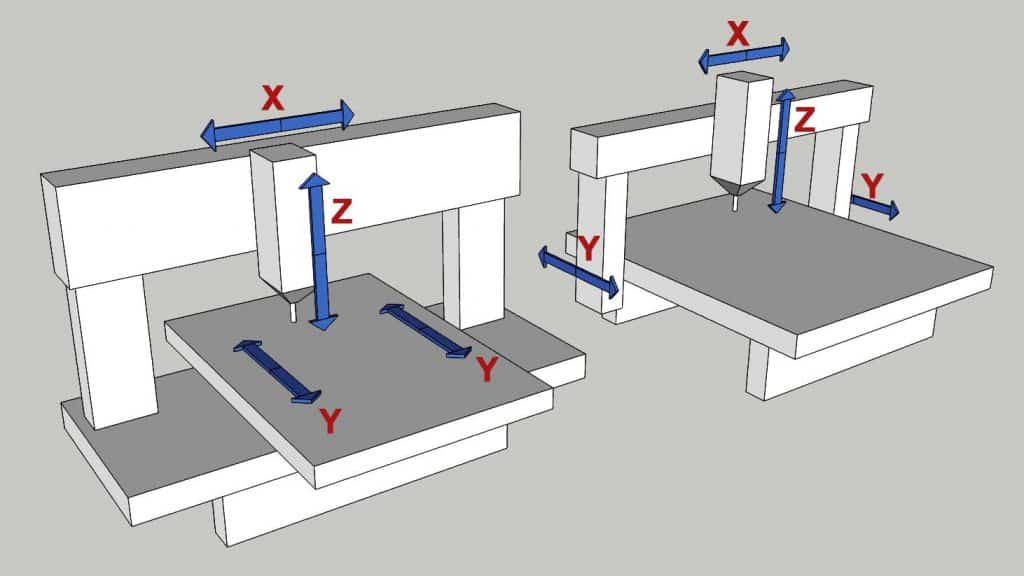
Choosing the right machine configuration based on specific application requirements is vital for maximizing efficiency and achieving optimal machining results. Evaluating factors such as the size and weight of the workpiece, the desired precision, and the operations’ complexity help in making an informed decision.
Gantry machine tools are computer numerical control (CNC) machines that features a gantry structure - a framework typically comprises two upright columns and a horizontal beam. This design allows for the movement of the gantry structure along one or more axes, enabling precise and controlled machining operations. Due to their distinct characteristics and advantages, Gantry machines are widely used in various industries, including aerospace, automotive, and construction.
Moving gantry systems are a special configuration of gantry machine tools where the gantry structure moves along the X-axis while the workpiece remains stationary. This configuration offers several benefits and is particularly useful when machining larger workpieces. For example, one of the key advantages of moving gantry machines is increased stability. The gantry structure, consisting of sturdy columns and a horizontal beam, provides a rigid framework that minimizes vibrations during machining operations. This stability is crucial for achieving high precision and accuracy, especially when dealing with larger workpieces prone to movement or vibrations.
Rigidity is another notable characteristic of moving gantry machines. The robust construction of the gantry structure ensures excellent resistance to deflection or bending, even when subjected to heavy cutting forces. This rigidity enhances the machine's ability to maintain consistent cutting parameters, improving surface finishes and dimensional accuracy. Moving gantry machines also offer versatility when it comes to machining larger workpieces. The stationary workpiece allows for easier access and maneuverability during the machining process. This configuration is particularly beneficial when machining complex or irregularly shaped components that require multiple cutting angles or approaches. The moving gantry system provides ample space for tooling and tool changes, enabling efficient machining of various features on the workpiece.
Additionally, the stationary workpiece in a moving gantry machine reduces the likelihood of errors due to workpiece movement. The machine can maintain consistent and precise cutting operations by eliminating the need for workpiece repositioning during machining, resulting in higher overall productivity and reduced cycle times. Moving gantry machines are also suitable for applications that involve heavy-duty machining. The robust gantry structure, combined with the stationary workpiece, allows for machining large and heavy workpieces without compromising stability or accuracy. This configuration provides excellent load-bearing capacity, making it ideal for tasks requiring high material removal rates or challenging machining conditions.
Furthermore, the versatility of moving gantry machines extends to the ability to integrate additional features or components into the machine setup. For example, the gantry structure can accommodate various auxiliary systems such as automatic tool changers, coolant systems, or part handling mechanisms. This flexibility enhances the machine's overall competence and enables seamless integration into automated production lines or manufacturing cells.
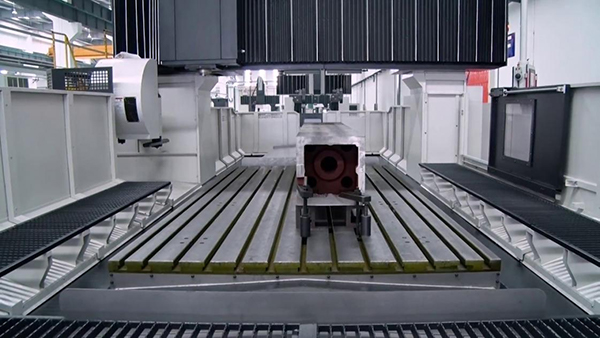
Selecting appropriate configuration for a machining system is vital for achieving optimal performance and productivity. When it comes to large-scale industrial machines, two common setups are the moving gantry (also known as moving column) and moving table (also known as a bridge) configurations. We will highlight the differences between these configurations and explore their structural and operational variances, focusing on the movement along the X-axis in the next sections. Furthermore, when talking about the moving gantry vs moving table debate, we will discuss the impact of each configuration on machine dynamics, precision, and accessibility.
The key distinction between a moving gantry and a moving table configuration lies in the arrangement of the primary moving component. For instance, in a moving gantry setup, the gantry structure, which consists of vertical columns supporting a horizontal beam, moves along the X-axis while the workpiece remains stationary. On the other hand, in a moving table configuration, the workpiece is placed on a stationary table while the bridge, which spans the width of the machine, moves along the X-axis.

• Structure: The moving gantry configuration typically features a robust gantry structure composed of vertical columns and a horizontal beam. This design provides excellent rigidity, stability, and resistance to vibrations.
• Operation: The gantry moves along the X-axis, carrying the cutting tool or spindle. This setup enables the machining of large workpieces, as the gantry can traverse the entire length of the machine.
• Advantages: The moving gantry configuration offers high rigidity, enhanced stability, and increased resistance to vibrations, resulting in improved machining accuracy and surface finish. It is suitable for heavy-duty applications that involve large workpieces.

• Structure: In a moving table configuration, the bridge spans the width of the machine and supports the cutting tool or spindle. It is typically composed of a bridge structure, often with additional support columns at the ends.
• Operation: The bridge moves along the X-axis while the workpiece remains stationary on the table. This configuration is commonly used for machining smaller to medium-sized workpieces.
• Advantages: The moving table setup provides easier access to the workpiece, simplifies workholding, and enables efficient chip evacuation. It is suitable for applications that require frequent workpiece changes and improved operator access.
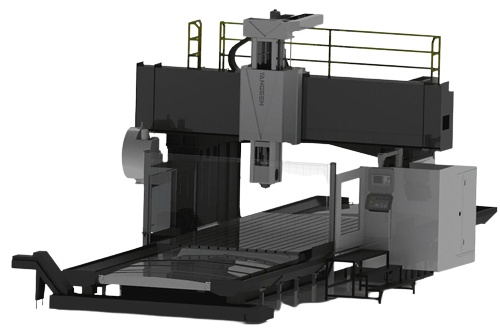
• Moving Gantry: The configuration offers superior machine dynamics due to its robust structure, reducing vibrations and ensuring high machining accuracy. It is suitable for applications that demand tight tolerance and precision.
• Moving Table: Although the moving table setup may be more susceptible to vibrations due to its bridge structure, advancements in design and construction techniques have mitigated this issue. Modern moving table machines can achieve high levels of accuracy and precision simultaneously.
• Moving Gantry: The inherent stability and rigidity of the moving gantry configuration contribute to enhanced precision. The fixed workpiece ensures minimal vibrations and superior surface finish and dimensional accuracy.
• Moving Table: While the moving table setup may have slightly lower inherent stability compared to the moving gantry, advanced damping techniques and structural optimizations help maintain high precision levels.
• Moving Gantry: As the gantry moves along the X-axis, operator access to the workpiece is limited. This configuration is more suitable for applications where direct operator interaction is not required during machining.
• Moving Table: The moving table setup offers improved accessibility, as the workpiece remains stationary while the bridge moves. This facilitates easier setup, tool changes, and inspection, making it advantageous for applications that require frequent operator intervention.
Choosing the right configuration, whether a moving gantry (moving column) or a moving table (bridge), depends on the specific requirements of the machining application. While the moving gantry offers increased stability, rigidity, and suitability for heavy-duty applications, the moving table configuration provides improved accessibility, ease of workpiece handling, and versatility for smaller to medium-sized projects. Understanding the structural and operational differences, as well as their impact on machine dynamics, precision, and accessibility, enables manufacturers to make better decisions and optimize their machining processes accordingly.
Factors to Consider in Choosing Between Moving Gantry and Moving Table
It is important to discuss the factors that influence the selection between moving gantry vs. moving table configurations, including workspace requirements, load capacity, machine footprint, accessibility for tool changes, and specific application needs. Furthermore, we will explore how the choice between moving gantry and moving table configurations affects machine performance, accuracy, and productivity, drawing insights from industry experts and real-world examples.
1. Workspace Requirements: The available floor space and the dimensions of the workpieces to be machined play a crucial role in determining the suitable configuration for your project. Assessing the spatial requirements helps ensure that the chosen configuration can accommodate the desired workspace while providing sufficient clearance for tool movement and operator access.
2. Load Capacity: The weight and size of the workpieces must be considered to determine the required load capacity of the machining system. As mentioned, moving gantry configurations are often preferred for heavy-duty applications large workpieces, as they offer higher load-bearing capabilities than moving table configurations.
3. Machine Footprint: The physical size and footprint of the machining system are important considerations, especially in facilities with limited space. Moving gantry configurations often have a smaller footprint than moving table configurations, making them more suitable for compact manufacturing environments.
4. Accessibility for Tool Changes: Depending on the specific application requirements, the ease and efficiency of tool changes can be critical factors here. Moving table configurations often provide better accessibility for tool changes, as the bridge can be moved away from the workpiece, allowing operators to access the tools and make adjustments more conveniently.
5. Specific Application Needs: The nature of the machining application, such as aerospace, automotive, or mold-making, can heavily influence your configuration choice. Each industry may have unique requirements regarding precision, workpiece size, and project complexity. Understanding these application-specific needs helps select the most suitable configuration that aligns with the desired outcomes.
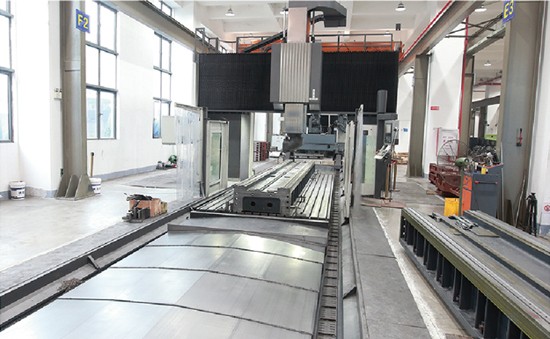
• Moving Gantry: With its robust structure and enhanced rigidity, the moving gantry configuration offers superior machine performance. The stability and resistance to vibrations result in improved cutting dynamics and reduced deflection, allowing for higher material removal rates and improved surface finish.
• Moving Table: While the moving table setup may have slightly lower inherent stability, design and construction technique advancements have narrowed the performance gap. Modern moving table machines incorporate structural optimizations and advanced damping techniques to mitigate vibrations, resulting in commendable machine performance.
• Moving Gantry: The rigidity and stability of the moving gantry configuration contribute to enhanced machining accuracy. The fixed workpiece ensures minimal vibrations and reduced tool deflection, resulting in precise cuts and dimensional accuracy.
• Moving Table: The moving table configuration can achieve high levels of accuracy with proper design and calibration. Although it may be more prone to vibrations due to the bridge structure, meticulous engineering can minimize this effect, ensuring accurate and consistent machining results.
• Moving Gantry: The configuration is well-suited for heavy-duty projects involving large workpieces. It allows the gantry to traverse the entire machine length, enabling efficient machining of long parts and reducing the need for repositioning. This setup promotes higher productivity by reducing idle time and increasing throughput.
• Moving Table: The moving table configuration excels in applications that require frequent workpiece changes or operator intervention. The accessibility provided by the moving bridge simplifies tool changes, setup, and inspection processes, improving overall productivity and minimizing downtime.
To support the decision-making process, we must consider insights from industry experts and real-world examples demonstrating each configuration’s benefits.
1. Aerospace Industry: In the aerospace industry, where precision and quality are paramount, moving gantry configurations are often preferred. These setups offer the rigidity to machine large components with tight tolerances, such as aircraft wings or fuselages.
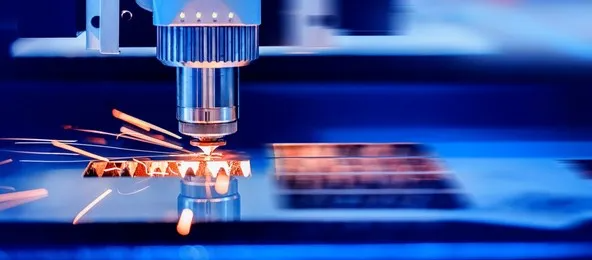
2. Automotive Industry: With its diverse range of part sizes and shapes, the automotive industry benefits from both moving gantry and moving table configurations. Moving gantries are commonly used for machining engine blocks or chassis components while moving table setups excel in applications such as mold-making for automotive body panels.

3. Mold-Making Industry: Moving table configurations are often favored in mold-making due to their accessibility and flexibility. Mold makers frequently require easy tool changes and frequent workpiece adjustments, making the moving table configuration an ideal choice.

Real-world examples from these industries demonstrate the successful implementation of the chosen configuration based on the specific application needs, resulting in improved performance, accuracy, and productivity.
Tesla, the electric vehicle giant, extensively uses moving gantry CNC machines in their manufacturing process. They faced numerous challenges in maintaining consistency and accuracy in manufacturing vehicle frames and battery packs - key components that require rigorous precision. By implementing moving gantry CNC machine configurations, the company enhanced accuracy and cut down production time. This, in turn, improved output and reduced errors, decreasing production costs and increasing overall efficiency.
Boeing, one of the biggest aerospace companies in the world, has been successfully using both gantry and moving table CNC machine configurations. The challenge lay in creating highly precise and consistent aircraft components. These CNC configurations proved the right solution, offering high precision while manufacturing complex parts. The introduction of CNC machines in their production line led to an estimated 20% reduction in production time and increased overall productivity by a significant margin.
IKEA, a multinational group that designs and sells ready-to-assemble furniture, was challenged to produce intricate designs on a mass scale without compromising on quality. Their implementation of moving table CNC machines was a game-changer. It allowed for highly complex designs to be precisely cut into various furniture pieces at a high production rate. This increased the variety of designs the company could offer to its target customers and boosted its production rate by approximately 15%.
Implementation moving gantry and moving table CNC machines has led to significant improvements in various industries. In the automotive sector, a study revealed a 30% increase in production speed and a 25% decrease in errors due to CNC implementation. In the aerospace industry, a reported 20% reduction in production time was recorded after the incorporation of CNC machines.
IKEA’s successful use of moving table CNC machines above illustrates how these machines can revolutionize production lines. The company reported a rise in its production rate by about 15% and increased variety in its product lines, which led to higher customer satisfaction.
These success stories and data highlight the practical benefits of moving gantry and moving table CNC machines in the real world. They not only help improve efficiency and accuracy but also give manufacturers the flexibility to design and manufacture complex products faster, thereby directly contributing to business growth and success.
There are several factors to consider when deciding between a moving gantry vs. a moving table design for CNC machines. These include load capacity, machine footprint, ease of tool changes, and application requirements. As a CNC business, we value your trust and want to help you choose the most suitable option for your requirements.
Moving gantry configurations are available from our CNC firm, Yangsen, and they give superior machine performance and enhanced load-bearing capacities. We also provide moveable table setups that take up less space and make tool changes easier.
Trust Yangsen to be your smart CNC machine partner. Contact us today to get a free quote.